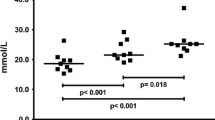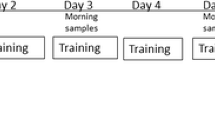Summary
To ascertain if muscle damage occurred in swimmers as a result of high-intensity training and to find if fluid and dietary manipulation could affect muscle damage, we studied 40 members of the University of Florida swimming team using creatine kinase (CK) and lactic dehydrogenase (LDH) as markers of muscle damage during a 6-month period of intensive training. During this time, training intensity, fluid intake during exercise and dietary supplementation were all modified one by one to examine their individual effects. During a control period of 4 weeks, all swimmers drank water before and during (120 min) workouts. CK in men at the end of this period averaged 315, SD 122 (normal < 170 IU · l−1). Half of the swimmers were then given 500 ml of a glucose-electrolyte solution (GES) (Na 21 mmol · l−1, Cl 13 mmol · l−1, K 2.5 mmol · l−1, PO4 5 mmol · l−1 and glucose 6%) before workouts and twice at intervals during the workout, while half continued to drink the same volume of water. One week after division into fluid groups, the workout intensity was increased by about 10%. Another week later CK had increased to 500, SD 180 IU · l−1 in swimmers drinking water, but fell to 280, SD 105 IU · l−1 in those drinking GES (P < 0.05). The second phase of the study began after a 4-week control period during which all athletes drank water before and during workouts. The swimmers were divided into four matched groups. Group I drank water before and during workouts and 250 ml of a 16% sucrose solution after; group II drank water before and during exercise and 250 ml of a milk protein supplement (MPS) containing 15 g lactalbumin and 16% sugar afterwards; group III drank GES before and during and the sucrose drink after exercise; group IV drank GES before and during and the MPS drink after exercise. Then during a 6-week period, the intensity of exercise was progressively increased by 25%. CK increased 61% (P < 0.01) in group I men, while it fell 12% (P < 0.05) in groups II and III, and 41% (P < 0.01) in group IV. In women, CK in group I increased 18% (P < 0.05); in group II it decreased 3.5%, in group III was unchanged, and in group IV declined 12.6% (P < 0.05). The final phase of the study was performed on 8 olympic swimmers who performed identical workouts each Saturday for 4 weeks. The 1st week they ingested water before and during exercise and the 16% sucrose solution afterwards. The 2nd week the GES solution was consumed before and during exercise and the sucrose solution afterwards. The 3rd week water was consumed before and during and MPS afterward and the 4th week GES before and during and MPS afterwards. Determination of CK and LDH before, immediately after, and at intervals afterwards showed that CK and LDH increased less when GES was the test fluid during exercise than when water was consumed. Recovery, as judged by return of CK and LDH to control values was more rapid when MPS was the post-exercise fluid than when the sucrose solution was given.
Similar content being viewed by others
References
Ahlborg G, Felig P, Hagenfeldt L, Hendler R, Wahren J (1974) Substrate turnover during prolonged exercise in man: splanchnic and leg metabolism of glucose, free fatty acids and amino acids. J Clin Invest 53:1080–1090
Davies CTM, White MJ (1981) Muscle weakness following eccentric work in man. Pflügers Arch 392:169–171
Decombaz J, Reinhardt P, Anantharaman K, Glutz G von, Poortman JR (1979) Biochemical changes in a 100 km run: free amino acids, urea and creatinine. Eur J Appl Physiol 41:61–72
Dohm GL, Hecker AL, Brown WE, Klain GJ, Puente FR, Askew EW, Beecher GR (1977) Adaptation of protein metabolism to endurance training. Increased amino acid oxidation in response to training. Biochem J 164:705–708
Dohm GL, Williams RT, Kasparek GJ, Rijam van AM (1982) Increased excretion of urea and N-methylhistadine by rats and humans after a bout of exercise. J Appl Physiol 52:27–33
Dohm GL, Kasparek GJ, Tapscott EB, Barakat HA (1985) Protein metabolism during endurance exercise. Fed Proc 44:348–352
Forbes PB (1985) Body composition as affected by physical activity and nutrition. Fed Proc 44:343–347
Friden J, Sjostrom M, Ekblom B (1983) Myofibrillar damage following intense eccentric exercise in man. Int J Sports Med 4:170–176
Hawk PB (1904) On the morphological changes in the blood after muscular exercise. Am J Physiol 10:384–389
Hikida RS, Staron RS, Hagerman FC, Sherman WM, Costill DL (1983) Muscle fiber necrosis associated with human marathon runners. J Neurol Sci 95:185–203
Hommen N (1985) Effect of volume depletion on the thermoregulatory system during exercise. Masters thesis, University of Florida Graduate School
Millward DJ, Davies CTM, Halliday D, Wolman SL, Matthews D, Rennie M (1982) Effect of exercise on protein metabolism in humans as explored with stable isotopes. Fed Proc 41:2688–2691
Nadel ER (1983) Effects of temperature on muscle metabolism. In: Knuttgen HG, Vogel JA, Poortsman J (eds) Biochemistry of exercise. Human Kinetics, Champaign, Ill., pp 134–143
Nadel ER (1984) Body fluid and electrolyte balance during exercise: competing demands with temperature regulation. In: Hales JRS (ed) Thermal physiology. Raven Press, New York, pp 365–376
Nadel ER (1985) Recent advances in temperature regulation during exercise in humans. Fed Proc 44:2286–2292
Nadel ER, Fortney SM, Wenger CB (1980) Effect of hydration state on circulatory and thermal regulations. J Appl Physiol 49:715–721
Newham DJ, Jones DA, Edwards RHT (1983) Large delayed plasma creatine kinase changes after stopping exercise. Muscle Nerve 6:380–385
Nose H, Mack GW, Shi H, Nadel ER (1988) Role of Osmolality and plasma volume during dehydration in humans. J Appl Physiol 65:325–331
Rennie MJ, Halliday D, Davies CTM, Edwards RHT, Krynawich S, Millward DJ, Matthews DE (1981) Exercise induced increase in leucine oxidation in man and the effect of glucose. In: Walser M, Williamson JR (eds) Metabolism and clinical implication of branch chain amino and keto acids. Elsevier, New York, pp 361–366
Troup JP, Barzdukas A, Arredondo SM, Richardson AB, Reese R (1991) Characteristic blood chemistry results of swimmers following various training periods. In: Cameron JM (ed) Aquatic sports medicine. Farrand Press, London, pp 73–74
Vaananan HK, Leppilampi M, Vouri J, Takala TES (1986) Liberation of muscle carbonic anhydrase into serum during extensive exercise. J Appl Physiol 61:561–564
Winer BJ (1971) Statistical principles in experimental design. McGraw-Hill, New York, pp 514–608
Author information
Authors and Affiliations
Rights and permissions
About this article
Cite this article
Cade, J.R., Reese, R.H., Privette, R.M. et al. Dietary intervention and training in swimmers. Eur J Appl Physiol 63, 210–215 (1991). https://doi.org/10.1007/BF00233850
Accepted:
Issue Date:
DOI: https://doi.org/10.1007/BF00233850




